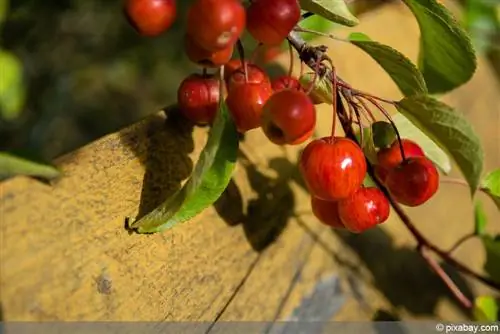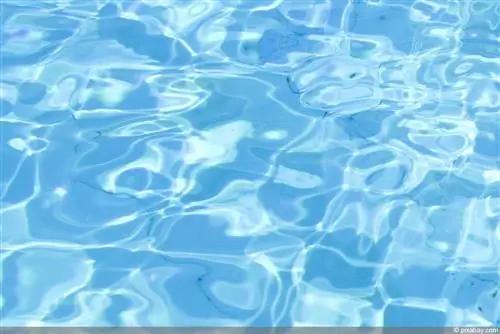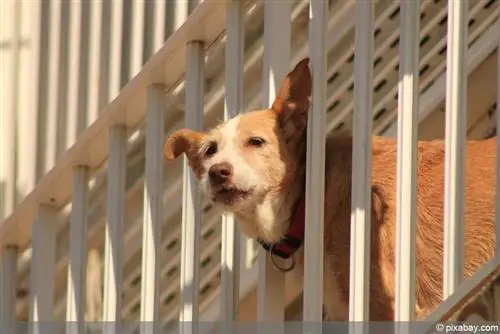- Author admin [email protected].
- Public 2023-12-17 03:39.
- Last modified 2025-06-01 06:48.
For a crabapple to present itself in the garden as a furious triad of fragrant flowers, lush green leaves and picturesque fruit decorations, the right cut is important. You don't have to read sophisticated treatises on professional fruit tree pruning. After reading this guide you will be familiar with all the aspects that need to be taken into account when cutting.
When is the best time?
Robust pruning tolerance allows you to make minor corrections throughout the growing season. For more extensive interventions, different times have proven to be effective in practice. The following overview summarizes the best dates:
- Shaping and maintenance pruning of the bush and treetop: between November and March
- Plumbing and trunk care on the crabapple tree: between June and September
- Rejuvenation cut: between January and March
- Pruning of bare-root hedge bushes: after planting in autumn or the following spring
- Garden bonsai thinning cut: after the flowering period, at the latest in autumn before the first frost
By choosing the exact date for the shape and maintenance pruning of the shrub and crown, you can influence further growth. If your crabapple is struggling with weak growth, the best time to prune is between November and January. If you want to reduce the growth rate, the ideal time window is February and March.
Why is pruning so tricky despite being well tolerated by pruning?

Whenever you cut your crabapple, a more or less large number of buds, flowers or fruits fall victim to the scissors. Unfortunately, the plant's good-natured pruning tolerance doesn't change this. Shortly after the end of the flowering period, the buds for the next year are created. If you want to forestall this process with a summer pruning, remove the plants for the autumn fruit decorations along with the withered flowers. Follow the times recommended here for shape and maintenance pruning during the leafless period, at least you will retain the joy of the colorful apples.
There is no silver bullet solution to the floral dilemma. A conservative incision has proven to be the best solution in practice. Cut a crabapple according to the rule of thumb: As much as necessary - as little as possible.
Tip:
The pretty, small fruits are not poisonous. However, crabapples are not suitable for fresh consumption due to their bitter taste. In some regions, resourceful housewives make jelly or jam from it. The colorful, solid apples are also suitable as craft material for imaginative autumn wreaths.
Crabapple tree - instructions for crown pruning and trunk care
As a house tree, crabapples are highly valued in private gardens. From the magnificent spring blossoms to a densely leafy crown in summer to the bright fruits in autumn, the ornamental tree proves to be a decorative reflection of the seasons. To keep it that way, scissors and saws should be used according to these instructions:
- Thin out dead, damaged and stunted branches in winter
- Cut off these shoots at the base without damaging the branch ring
- Short branches that are too long and too low
- Place the scissors at a distance of 3 mm from a bud
- In summer, cut or tear off side shoots below the crown from the trunk
To remove a thick branch more than 5 cm in diameter, proceed in stages. At a distance of 10 to 20 cm from the trunk, saw the shoot from the bottom down to the middle. Now move the saw a few centimeters and cut from above until the branch breaks off. Support the remaining stump with your hand and position the saw so that the bulging branch ring is not injured during the cut. Please do not leave any coat hooks. At this point the wood dries back, dies and offers pathogens a welcome target.
Guide to cutting as a solitary garden shrub
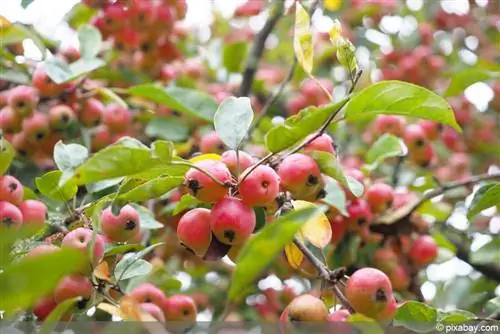
Crabapple hybrids, such as 'Evereste' or 'Golden Hornet', are the jewels among the solitary flowering and fruiting shrubs. The rapid growth of up to 80 cm per year makes pruning essential when the spatial dimensions of the garden are exceeded. Annual thinning effectively prevents baldness from the inside out. This guide summarizes what needs to be taken into account when caring for prunes:
- Thimout dead wood every late winter
- From the fifth year onwards, cut off the two oldest ground shoots at the base
- If necessary, shorten shoots by a maximum of a third
- Always cut within a short distance of a bud, leaf or sleeping eye
If a large crabapple bush grows over your head during the summer, shorten the branches to the desired height immediately after flowering. More than a third of the foliage should not be removed during the growing season so as not to weaken the plant. In this case, wait until after St. John's Day, because subsequent budding will be lower from this point onwards.
Tip:
Almost all crabapples are grafted onto wild apple (Malus sylvestris). Cheeky wild shoots sprout from this base all year round to overgrow the noble part of the plant. As soon as you see a water shooter, tear the shoot off the base with a courageous tug.
Cut crabapple hedges correctly - this is what you should pay attention to
Shrub-like crabapple species, such as Malus floribunda and Malus toringo sargentii, are planted in rows to form a magnificent privacy hedge. These two types of crabapples bloom and fruit well even after topiary. By purchasing bare-root products from the nursery, you can significantly reduce the purchase price. Apart from the fixed planting season between October and April, the only difference to high-priced container goods is a planting cut. When it comes to subsequent pruning care, bare-root and potted ornamental apple bushes work together. How to do it correctly:
- Cut back bare-rooted young plants by a third after planting
- Poted young bushes do not receive any pruning
- From the third year onwards, thin out the hedge thoroughly every late winter
- Cut off dead wood, weak and inward-facing shoots at the base
So that a head-high, densely branched hedge can quickly form, trim the bushes during the leafless period from November to January. At this point, pruning gives the growth a lot of momentum. Only when the hedge has reached its final height or you want to slow down annual growth should you use the scissors between February and March. Please note that the more vigorously you cut back the shoots, the more buds you will remove. Therefore, limit the amount of cutting to what is absolutely necessary if you do not want to deprive yourself of this year's blooms.
When making the cut, pay attention to an advantageous trapezoidal shape. As a crabapple hedge tapers slightly from bottom to top, sunlight reaches deep into the interior of the bushes. Because of this, the shoots can produce leaves close to the ground, so that the hedge does not become bare.
Rejuvenation pruning on shrubs and treetops - How to do it right
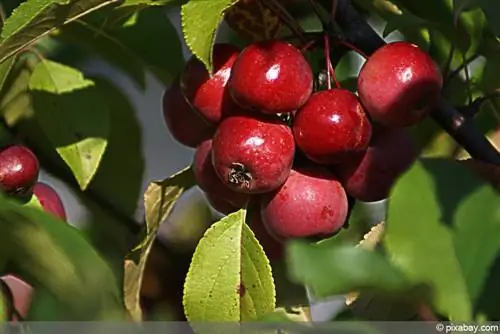
In order not to impair the beautiful flowers and the wonderful fruit decoration, careful home gardeners do not cut the crabapple at all. This results in the bush or crown aging. The increasing amount of dead wood shades the shoots so that leaves and flowers can no longer thrive. You can solve the problem with a rejuvenation cut. This is how it works:
- The best time is a frost-free day in winter
- In the first step, cut off all dead branches at the base
- Thinning out weak, sick and damaged shoots
- Cut the remaining main shoots back to 30 to 50 cm
Long rods sprout from this base structure from spring to autumn. Leave three to four strong side shoots on each main branch. Shorten these by a third or half of their length. Place the scissors over an outward-facing bud to direct further branching in the right direction. It is important to note that you cut these young shoots back to different heights so that a harmonious shape of the bush and crown can develop. Branches in the center should extend beyond the side branches by a few centimeters.
Tip:
Methods for wound closure are no longer up to date. Sealing larger cuts with an airtight paste has been shown to be counterproductive. The only exception is wounds with the diameter of a 2 euro coin or larger if they occur in the middle of winter. Just apply a thin coat of tree wax to the edges of the wound to protect the frost-sensitive cambium wood until spring.
Crabapple bonsai - instructions for pruning care
In the small garden and on the balcony, graceful crabapple bonsai varieties boast lavish abundance of flowers and autumnal crabapples. While their impressive counterparts grow up to 6 meters high and 2 meters wide, dwarf varieties remain at a height of 1 to 1.5 meters. In addition, annual growth is limited to a leisurely 15 to 20 cm, so cutting back the branches is usually not necessary. The focus of pruning care is annual thinning. If you cut dead branches out of the crown or bush in autumn or winter, you will see a lavish display of flowers again next spring.

